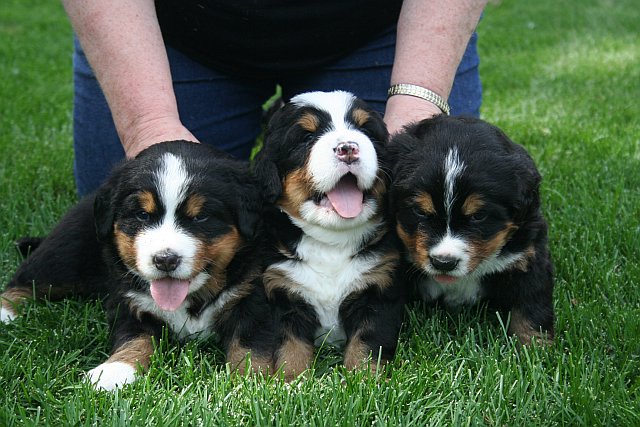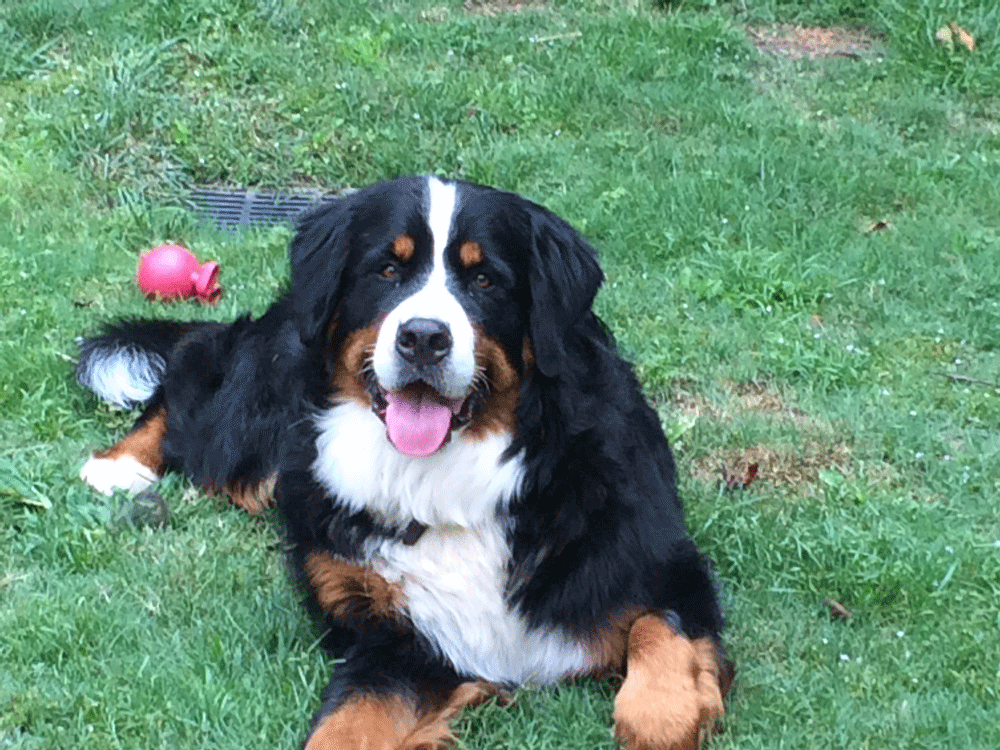Why do we raw our dogs and puppies holistically and what does that mean? We feed our dogs and puppies a biologically species appropriate raw diet. This means that get raw meat and bones and sometimes vegetables and fruit. Please note – this means raw, not cooked bones. Cooked bones can splinter and puncture a dog’s intestines. However, raw meat and bones are broken down by the dog’s acids and enzymes and we feel it’s a superior way to feed our dogs. Since feeding raw, (since 2000) ALL of our dogs have lived past the average lifespan of a berner, which is only 7 years old. We want more than that for our dogs and we can’t complain about the results! We also do the bare minimum in vaccines and we do a nomograph on our pregnant girls, so that we can determine the optimal time in which the puppies should have vaccines. We do not want to give any unnecessary vaccines! Food and vaccines are just the tip of the iceberg of what we do holistically, but we feel these two things are the most important things you can do for your dog.
More info on how a nomograph is used – https://www.vetmed.wisc.edu/lab/cavids/canine-nomograph-what-is-it/
There are plenty of websites to feeding a raw species appropriate diet, here is just one to get started – https://www.thenutritioncode.info/
Why do we require at least one session (usually 6 weeks) of obedience in our contract? Well, Bernese are very large dogs and while adorably cute, they are exuberant puppies and young adults and they are also opportunistic. While we do raise our puppies with the Puppy Culture protocol, which teaches them (manding (sitting or standing for petting), walking nicely on a leash, beginning potty training), the new owner will get their puppy around 9 or 10 weeks and old and you will need to continue the training. Otherwise, that cute little 20 pound puppy, will turn into a 90 pound idiot that is jumping on you and guests, dragging you everywhere and pottying everywhere but outside. Attending obedience class with a great trainer will pay off more than you can imagine! Plus, you should know that we are available to help answer your questions. We don’t put the amount of work that we do into our puppies, if we didn’t care about how they live the rest of their lives.
How come I can’t choose my own puppy? – We do not breed very often and when we do, we are breeding first and foremost for ourselves because we plan on keeping a puppy to hopefully show & possibly breed, (we don’t even know if the puppy we keep will turn out to be show quality). So when we have a litter, we plan on keeping the “Pick” puppy for ourselves so that we can continue to breed quality dogs. “Pick Puppy” might be a boy or girl, we don’t know until the litter is evaluated between 7 & 8 weeks old. We are evaluating the litter for conformation (structure & movement) and temperament. Once we have decided which puppy we are keeping as the breeder of the litter, then we may have other people that we have committed a puppy to, usually experience dog show people that are going to show their dog. We will then place any other “show potential” puppies in those homes. After that we then try to match the temperament of the rest of the puppies with wants of the remaining families. We as the breeders have been with these puppies practically every moment of these puppies lives for the first 8 weeks, and we have a general feeling for the puppies’ activity levels and temperaments. For instance, if someone who is really laid back in temperament wants a puppy that is laid back, we’d be silly to let that person pick a high energy puppy. That would be a recipe for disaster! In turn, if someone has told us that they love to jog or hike, and/or wants to compete in performance events, we then are watching the puppies for those talents that they may already be showing us while we are raising them. Ultimately we want every family that purchases a puppy from us to be happy with their dog!
I paid for my dog, why can’t I use him or her in a breeding program?
We only want to produce dogs that we hope fulfill the standard that is set by the Bernese Mountain Dog Club of America. There is a standard for a reason, so that Berners will always look like Berners, not a dog that looks like a tri-colored Aussie or Border Collie. When have all our puppies evaluated for conformation (structure, proportion, substance and movement and to a lesser extent markings) between 7 – 9 weeks. Those puppies that are not deemed as breeding potential are sold as pets/non-breeding. We make it very clear in our pet/non-breeding contract that the dog will not be used in any sort of breeding (pure or mixed). We will not hesitate to enforce our contract.
What Will My Puppy Look Like as An Adult? – Most people decide that they want a Bernese Mountain Dog after meeting an adult. There is no doubt that a fully mature adult BMD is a beautiful, striking, impressive dog. However, that beautiful dog was probably at one time a wild, gangly teenager. Depending on the pedigree of the dogs in being bred, some puppies will stay proportionate their whole lives, while others will initially grow taller far faster than they will wider. We have no way of knowing what that little 8 week puppy will look like as an adult. We can guess, based on what the parents look like, but there are no guarantees in life. The smallest puppy in a litter could end up staying on the smaller side his or her whole life, or many times we see that they blossom and grow into a normal sized berner.
In addition, BMDs come in a wide variety of markings and coat types. Coat types many times will depend on which lines (pedigrees) dogs are from. We have had dogs in our family with a wide variety of coat types and markings. The BMDCA standard says: “The coat is thick, moderately long and slightly wavy or straight. It has a bright natural sheen. Extremely curly or extremely dull-looking coats are undesirable. The Bernese Mountain Dog is shown in natural coat and undue trimming is to be discouraged.”
When you get a puppy, it will have a coat similar to a bear. It is thick, soft, with just a little wooliness to it. As your puppy gets older, that coat will become dull and they will then begin to shed. All of a sudden, you will see a shiny and sometimes very curly coat develop. Don’t worry, while they may have that coat for several months, (and it is usually when they are in the kind of ugly, gangly stage), once they get their adult coat, you will eventually see the adult coat that is called for in the standard. You will often see with each year as your puppy develops, your dog’s head will also get wider, along with the rest of the body.
Here are some pictures to illustrate the changes that our puppies that we have produced have gone through.
Ruby’s 1st litter at 6 weeks – Breeze is on the left, Heidi is in the middle and Chip is on the right side

Heidi at 3 years

You can see how the markings are quite a bit different within puppies from the same litter, but both have grown into beautiful adults, regardless of the markings. This is because they have lovely breed type (size and substance). In the whole scheme of things, markings are nothing in comparison to having a happy and healthy dog!
Please read this page for some of the most “Frequently Asked Questions”. This page comes from the Bernese Mountain Dog Club of America. These pages might be of help in answering some general questions about costs, breeders, etc. https://tollhauskennels.com/wp-content/uploads/2019/07/03_bernese_basics_faq.pdf
Here is another great page of information to read before purchasing a puppy from anyone – https://tollhauskennels.com/wp-content/uploads/2019/07/12_bernese_basics_buying_tips.pdf
